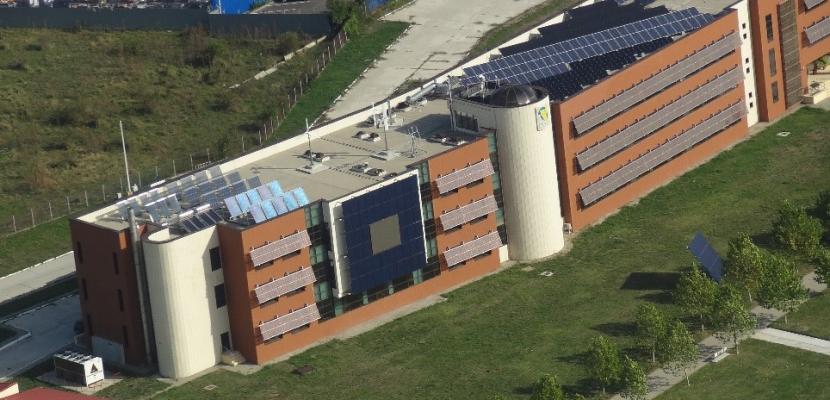Image

HVACR integrated Control System with weather compensation and Solar Thermal input
Published on 30 July 2020

Romania
Sud-Muntenia
This is the good practice's implementation level. It can be national, regional or local.
About this good practice
Problems addressed:
1. HVAC system low efficiency
2. Solar Thermal (ST) generator usage as thermal input for HVAC, instead of DHW.
The practice reaches its objectives through the following enabling scenarios:
- Load optimisation based on weather compensation applied on: heat generators (natural gas burners), refrigeration unit (air-water heat pump) and distribution circuits.
- Solar Thermal interconnect at the HVAC distribution level on 2 circuits operated by weather compensated setpoints.
The HVAC system is comprised of boilers (1700kWth), chiller (heat-pump 657kWth), Air Handling Units (AHU 13000m3/h), Radiators and Fan Coil units (FCU). The ST generator is comprised of heat-pipe and plane solar collectors (26kWp) coupled with 3 tonnes hot water storage and 2 adsorption chillers (32kWp). From a technical point of view the HVAC system is controlled by a Building Automation and Control System (BACS or BMS) and the ST generator by a dedicated controller.
Results obtained: Natural gas consumption levels were lowered by half compared to manual operation with static setpoint. Electricity economies by setpoint reset based on weather compensation and fine-grained scheduling also brought huge impact comparedto manual fixpoint operation. Thermal input from ST covers, for a nZEB laboratory type of building, heat needs in spring and autumn seasons.
Main stakeholders and beneficiaries: Institute’s researchers and the University administrative body.
1. HVAC system low efficiency
2. Solar Thermal (ST) generator usage as thermal input for HVAC, instead of DHW.
The practice reaches its objectives through the following enabling scenarios:
- Load optimisation based on weather compensation applied on: heat generators (natural gas burners), refrigeration unit (air-water heat pump) and distribution circuits.
- Solar Thermal interconnect at the HVAC distribution level on 2 circuits operated by weather compensated setpoints.
The HVAC system is comprised of boilers (1700kWth), chiller (heat-pump 657kWth), Air Handling Units (AHU 13000m3/h), Radiators and Fan Coil units (FCU). The ST generator is comprised of heat-pipe and plane solar collectors (26kWp) coupled with 3 tonnes hot water storage and 2 adsorption chillers (32kWp). From a technical point of view the HVAC system is controlled by a Building Automation and Control System (BACS or BMS) and the ST generator by a dedicated controller.
Results obtained: Natural gas consumption levels were lowered by half compared to manual operation with static setpoint. Electricity economies by setpoint reset based on weather compensation and fine-grained scheduling also brought huge impact comparedto manual fixpoint operation. Thermal input from ST covers, for a nZEB laboratory type of building, heat needs in spring and autumn seasons.
Main stakeholders and beneficiaries: Institute’s researchers and the University administrative body.
Resources needed
Prerequisites: operational HVAC and ST systems
Equipment’s: freely programable controllers (PLCs), 3way valves, sensors and transducers, communication interfaces for new HVAC or dedicated controls for legacy equipment, hydraulic interconnects, security valves and expansion vessels.
Equipment’s: freely programable controllers (PLCs), 3way valves, sensors and transducers, communication interfaces for new HVAC or dedicated controls for legacy equipment, hydraulic interconnects, security valves and expansion vessels.
Evidence of success
The integration of all components into a single system provides higher performance levels. We observed natural gas economies of over 40% compared to manual setpoint operations.
Using solar thermal as a heat input for HVAC is dependent on the net energy balance. Dimensioned only for 2 seasons in a nZEB building, our system provides up to 120 days of only solar powered HVAC. The ST electric needs are covered - by an off grid photovoltaic battery backed generator.
Using solar thermal as a heat input for HVAC is dependent on the net energy balance. Dimensioned only for 2 seasons in a nZEB building, our system provides up to 120 days of only solar powered HVAC. The ST electric needs are covered - by an off grid photovoltaic battery backed generator.
Potential for learning or transfer
Weather compensation and integration of all HVAC assets into a single automation system could be easily (and with IoT solutions cheaply) replicated on any other site. This could be seen as: high COPEX with low OPEX, if the system integrates pre-emptive and predictive maintenance.
Onsite, large enough solar thermal generators, if installation space allows, provide good heat input for low temperature modern HVAC systems.
Know-how transfer is free of charge for project partners or H2020 consortiums. Please contact GP owner (LET Dorin).
Onsite, large enough solar thermal generators, if installation space allows, provide good heat input for low temperature modern HVAC systems.
Know-how transfer is free of charge for project partners or H2020 consortiums. Please contact GP owner (LET Dorin).
Further information
Website
Good practice owner
You can contact the good practice owner below for more detailed information.
Organisation
Institute of Multidisciplinary Research for Science and Technology from Valahia University of Targoviste

Romania
Sud-Muntenia
Contact
Director